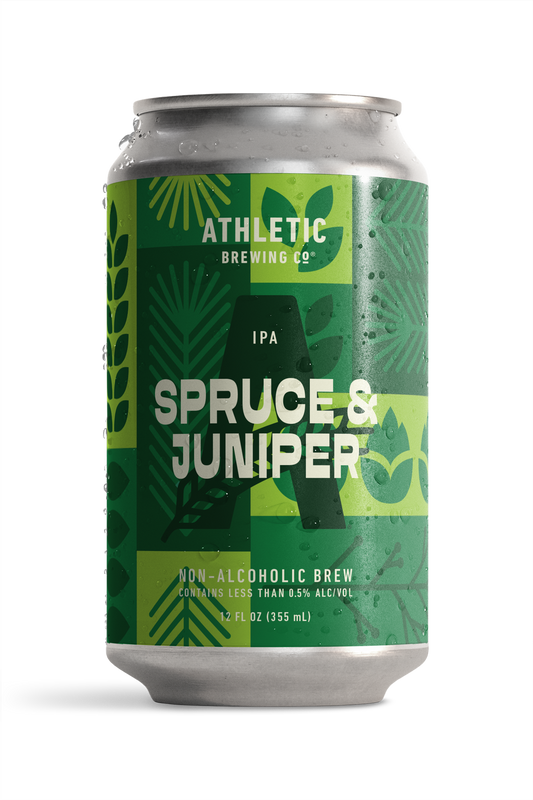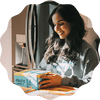Exploring the Pursuit of Going Up
Athletic Brewing Ambassador, Emily Keddie, gathers her gear and neatly lays it out on the floor. Her ski gear is organized on one side of the room, and everything else is in rows on the other side. Skis, boots, skins, a variety of beverages and lots of snacks are all present and accounted for. She’s ready. Or as ready as she can be.
The following morning, Emily and her friend, Erica Raggio, set out on their skis with a goal of ‘Everesting’. To ‘Everest’ is to climb the equivalent of the height of Mount Everest, which is 29,032 feet. So Emily and Erica would skin up, remove their skins, ski down, apply their skins, and repeat.

Over and over again, they skinned up and skied back down, each time racking up between 500 and 1,400 feet of vertical gain. Over a 24 hour period, Emily and Erica covered 29,337 feet of vertical ascent - more than the height of Everest - all in order to bring awareness to climate change and support the nonprofit organization, Protect Our Winters.
There is an art to managing the kind of suffering that comes along with these endeavors. “Embrace the suck and make it fun whenever you can,” Emily says. “Things can suck and be fun. Things can be hard and enjoyable. The things we work at the most are usually the most rewarding.”
Not long before her Everest attempt, Emily had taken on a similar challenge during Vertfest, climbing 83,037 feet on skis over a period of nine days in support of the Central Oregon Avalanche Center. Around the same time, professional ski mountaineer, Caroline Gleich, climbed 31,319 feet on skis in a 24 hour period, and ultra runners Nate Bender and Dakota Jones climbed 16,700 feet on foot (sans skis) in a 12 hour period. All of the latter efforts were to help bring awareness to climate change.
This last year has seen a lot of record breaking activity. The women’s vertical ascent record on skis was broken twice in March of this year, first by Rea Kolbe with 55,045 feet of vertical gain, then it was broken again just a couple of weeks later by Martiskka Martina Valmassoi, with 57,890 feet of gain. The men’s vertical ascent record on skis has been held by ultrarunning and ski mountaineering legend, Kilian Jornet, since 2019 with an astounding 78,274 feet, a little more than two and a half times the height of Everest.

The men’s on-foot record was broken three times in the last year as well. Juha Jumisko climbed 52,670 feet on June 5th, then Luca Manfredi Negri racked up 53,853 feet less than two weeks later. Finally, on September 6th, 2020, Aurelien Dunand-pallaz climbed 56,489 feet - the current standing record. The women’s on-foot record was also broken last September by Elise Delann with 54,370 feet of climbing, which would have been the overall record had Aurelien not made his attempt.
Obviously there is a huge attraction to these amazing feats. We like watching them, we like reading about them, we cheer our friends on, and we donate money in support. But what is it about these half-crazy sufferfests that people are so willing to take on?
The Why
These challenges aren’t just physical, they’re very much mental, especially when you’re skiing the same track on repeat for 12 to 24 hours straight. It can get really difficult, not just physically, but emotionally. “You have to stay focused and stay positive,” Emily says. “You have to, in order to keep going, to survive. You’ve got to find motivation somewhere. A lot of my motivation comes from wanting to show the world what women can do.”
This is where the ‘Why’ is important.
There are a lot of reasons that people are drawn to these kinds of challenges, some reasons are deeply personal, and others are related to a bigger picture. It’s about creating and strengthening communities, doing good for others, and doing good for yourself.
Back in December, Athletic Brewing Ambassador, Jesse Holden, spent 12 hours hiking and jogging his way to 13,200 feet of vertical gain by doing laps on Mt. Pisgah. But he wasn’t doing it for himself, Jesse was doing it to raise money for a local nonprofit, Umbrella, that fights to end domestic violence. He was able to donate $6,000 to the organization. “It opened my eyes to so many beautiful aspects of humanity,” Jesse says, “kindness, generosity, humility, strength, friendship, community… the list could go on and on!”

Emily explains that one of the many reasons she takes on endurance events is to test her limits. “Doing things I didn’t know I could do, and pushing myself past what is comfortable, to explore what exists on the other side. To me, that is where I get a rush of adrenaline, and a huge reward for going to a novel place both mentally and physically.”
Your ‘why,’ or the reasons you’re taking on the challenge, is a topic that is frequently discussed amongst the endurance athletes of the world. Why do I do this? Why push myself to exhaustion? When things get really tough, what are the reasons that will pull me through to the other side?
Knowing your ‘Why’ helps you push through the thick of it.
Bigger Than the Self
One of the common threads that we see amongst these endurance athletes is that of bringing awareness to an issue that’s important to them, to raise money for an organization, or use it as a platform to educate others. Many of the athletes above pushed their limits in the name of climate change, to empower women, and to prevent domestic violence. The reasons these athletes do what they do are rarely selfish, small, or insignificant. While they do have an intrinsic motivation to push themselves and test their limits, the ‘Why’ is almost always bigger than the ‘Self.’
With shared goals, collaboration, and mutual belief in a good cause, there’s a coming together of people during these events that builds community. New friends are made as they connect over a mutual objective.
Recently, there was an attempt to take the North American vertical ascent record on skis by Ryan Ghelfi of Ashland, Oregon. While his goal was to break the record and see what he was capable of doing within that 24 hour time window, he also wanted to bring the community together. His curiosity about his abilities coupled with the incredible support of the people of Ashland that surrounded him, pushed him to climb 58,600 feet, a mere 3,000 feet away from the North American record held by Mike Foote. The community of Ashland rallied around Ryan in support, and many came away feeling motivated, inspired, and connected to one another.
We see it in the ultrarunning community, amongst skiers, triathletes, Spartan racers, mountaineers, cyclists, backpackers... any sport that allows for an extended period of time spent suffering. We see athletes endure relentless climbing while advocating for public lands, we see them bringing awareness to meaningful issues, we see them educating others, being allies, raising money, and speaking up for those who are underrepresented. These are the people that come together and volunteer their time to work with organizations that promote outdoor recreation and education, help build and maintain trails, clean up climbing areas, and seek out opportunities to help their outdoor community, like our Two for the Trails Grant.
Of his experience doing laps on Mt. Pisgah, Jesse says, “One of my biggest takeaways was ‘do the things you love, and speak up for what you believe in.’ If you do this, all these things can come together in really special ways, showing you new and super rewarding ways to live your life!”
























 Your Privacy Choices
Your Privacy Choices











